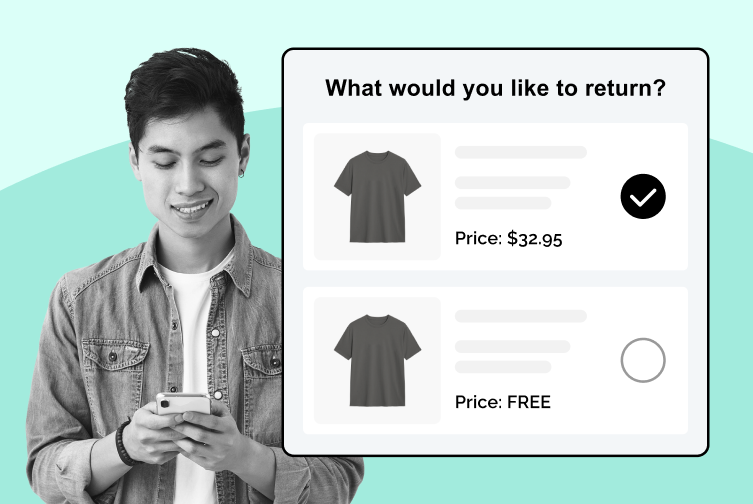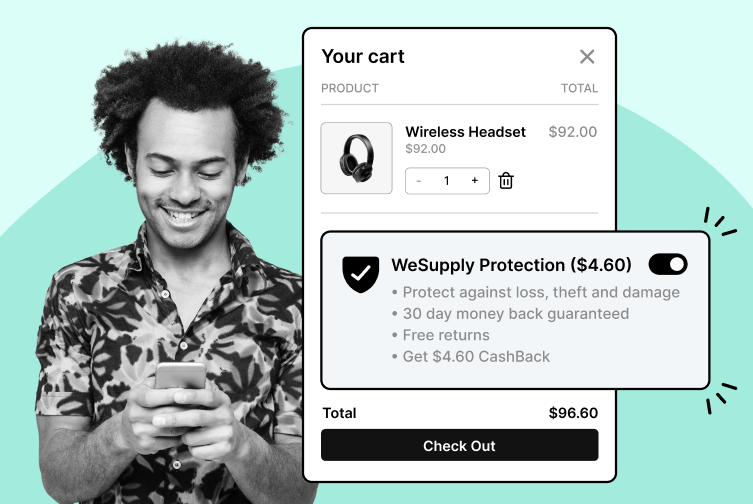
How to Handle BOGO Returns Without Charging Customers for the Free Item
Learn how to manage BOGO returns effectively while ensuring customers aren’t charged for the free item. Practical solutions!
Shipping, Tracking & Notifications
Boost customer experience and reduce support tickets
Realtime order and shipment tracking
Proactive order and shipping notifications
AI-Enhanced Discounted Labels
Predictive pre-purchase estimated delivery dates
Self-Serivce branded order tracking
Effortless experience delivered
Identify and Resolve Order Issues
Realtime order and shipment tracking
Make returns profitable and delight customers
Flexibility to define any return destinations & conditions
Simplify returns for your customers and team
Incentivize exchanges over returns
Returns management made easy for your team
Returns management made easy for your team
Easy claims and smart upsells
Understand why your customers are returning
In-Store & Curbside Pickup
Unify the online and the in-store experience
Hassle-free pickup experience for customers
In-Store dashboard to keep operations streamlined
In-Store and Online orders unified
Drive foot-traffic to your stores
Shipping, Tracking & Notifications
Boost customer experience and reduce support tickets
Realtime order and shipment tracking
Proactive order and shipping notifications
AI-Enhanced Discounted Labels
Predictive pre-purchase estimated delivery dates
Self-Serivce branded order tracking
Effortless experience delivered
Identify and Resolve Order Issues
Realtime order and shipment tracking
Make returns profitable and delight customers
Flexibility to define any return destinations & conditions
Simplify returns for your customers and team
Incentivize exchanges over returns
Returns management made easy for your team
Returns management made easy for your team
Understand why your customers are returning
In-Store & Curbside Pickup
Unify the online and the in-store experience
Hassle-free pickup experience for customers
In-Store Dashboard to keep operations streamlined
In-Store and Online orders unified
Drive foot-traffic to your stores
Boost customer experience and reduce support tickets
Realtime order and shipment tracking
Proactive order and shipping notifications
AI-Enhanced Discounted Labels
Predictive pre-purchase estimated delivery dates
Self-Serivce branded order tracking
Effortless experience delivered
Make returns profitable and delight customers
Flexibility to define any return destinations & conditions
Simplify returns for your customers and team
Incentivize exchanges over returns
Returns management made easy for your team
Equip your team for precise return checks.
Easy claims and smart upsells
Understand why your customers are returning
Unify the online and the in-store experience
Hassle-free pickup experience for customers
In-Store Dashboard to keep operations streamlined
In-Store and Online orders unified
Drive foot-traffic to your stores
Find the answer to all your questions
Take a step by step trip through our functionality to see how we can improve your ecommerce processes.
Explore the most comon questions about WeSupply
Calculate the ROI that WeSupply can bring you
Read actionable articles on how to optimize your post-purchase experience and decrease support tickets
Get inspired by stories of how our customers implemented an effortless post-purchase experience
Wondering if WeSupply is a good fit for you? Read through our use cases to see how we can help you increase conversion & improve CX!
A Deep Dive into Top Companies' Order Tracking & Returns Strategy
Find the answer to all your questions
Explore the most comon questions about WeSupply
Calculate the ROI that WeSupply can bring you
Request a no strings attached review of your current shopping experience and missed conversion opportunities
Take a step by step trip through our functionality to see how we can improve your ecommerce processes.
Read actionable articles on how to optimize your post-purchase experience and decrease support tickets
Get inspired by stories of how our customers implemented an effortless post-purchase experience
A Deep Dive into Top Companies' Order Tracking & Returns Strategy
Wondering if WeSupply is a good fit for you? Read through our use cases to see how we can help you increase conversion & improve CX!

In today’s hyper-competitive ecommerce landscape, reducing return volume is more important than ever. Product returns are a significant challenge in online shopping and e commerce, impacting both profitability and customer satisfaction. Not only do high return rates eat into profit margins due to shipping costs and restocking logistics, but they can also erode customer trust and brand reputation. As the cost of customer acquisition continues to rise, every sale counts and every return risks being a missed opportunity.
Fortunately, there is a growing solution: real-time product feedback. By capturing, analyzing, and acting on customer feedback as it happens, ecommerce businesses can address common causes of customer returns and reduce product returns in the context of online shopping. This approach allows brands to better understand customer expectations, improve product content, enhance the shopping experience, and ultimately retain more revenue.
In this article, we’ll explore how real-time feedback can reduce returns, the effective strategies you can implement to make it work, and how to integrate it with your existing ecommerce ecosystem to drive lasting results.
Returns don’t just happen because a product is defective. In many cases, it’s a mismatch between what the customer expected and what they received. Understanding these expectations begins with listening to your customers and there’s no better way to do that than through real-time product feedback.
Customer expectations are diverse. Some shoppers care about size and fit, others about color accuracy, material feel, or ease of use. Real-time feedback mechanisms such as post-purchase surveys, live chat transcripts, and product review prompts can reveal what your customers value and where expectations are falling short. Customer reviews and feedback from previous customers and real customers provide valuable insights for both the business and other customers, helping to build trust and guide new buyers.
When ecommerce stores collect and analyze this information promptly, they can identify patterns across product lines or categories. For example, if many customers comment that a blouse “runs small,” your product team can add sizing notes or revise the size chart. If there’s consistent confusion about how to operate a gadget, you can create more intuitive instructions or an explainer video. Addressing customer questions and customer queries helps ensure customers make informed purchase decisions.
Real-time product feedback empowers your brand to make informed adjustments quickly before these issues lead to returns. Studies show that at least half of consumers are willing to leave reviews when prompted, which can help inform future customers and support more informed purchases.
Real-time interaction is a game-changer for ecommerce stores aiming to minimize returns and boost customer satisfaction. When customers can connect instantly with knowledgeable customer service agents, they receive the accurate information they need to make informed purchasing decisions. This immediate support helps clarify product details, address sizing or compatibility questions, and resolve any uncertainties before a purchase is made.
By offering real-time assistance, ecommerce stores can ensure customers have the right expectations about their orders, which significantly reduces the likelihood of ecommerce returns caused by misunderstandings. Quick, personalized responses not only improve customer satisfaction but also foster a sense of trust and reliability, encouraging customers to return for future purchases.
Moreover, real-time interaction empowers customer service agents to proactively guide customers, helping them choose the right products and avoid common pitfalls that lead to returns. This approach not only minimizes returns but also strengthens customer retention, as shoppers are more likely to stay loyal to brands that prioritize their needs and provide exceptional support. In today’s competitive landscape, improving customer satisfaction through real-time interaction is essential for long-term success.
Your product page is your digital storefront. It’s where shoppers make their final decision and it’s also where many returns originate if expectations aren’t managed correctly.
By using real-time feedback to continuously refine product content, ecommerce stores can reduce the risk of surprises upon delivery. For instance, if customers frequently comment that a fabric feels different than expected, this can prompt your team to include better texture descriptions, close-up images, or even video clips showing the material in action. Providing detailed product descriptions and high quality product images, including multiple angles, helps potential customers examine products thoroughly and make informed choices.
Adding product dimensions, lifestyle images, and fit details based on live customer input ensures buyers know exactly what they’re getting. Be sure to include detailed measurements and comprehensive product detail on the product detail page, so customers have all the information they need. Helping customers visualize products with accurate product images and detailed information supports a confident purchase decision.
Consider showcasing recent feedback on the product page itself. Highlighting that “93% of customers say this fits true to size” or “most users found the setup easy” can reinforce buyer confidence and provide reassurance.
Post-purchase surveys are one of the most effective tools for gathering real-time feedback. These short questionnaires, sent via email or integrated directly into order tracking pages, give customers an opportunity to share their thoughts while the experience is still fresh.
The key is to keep these surveys brief and focused. Ask questions like:
Was the product as described?
Was the size/fit/color accurate?
What did you like or dislike about the product?
Would you recommend this to others?
By analyzing responses in real time, your team can quickly identify problematic products, recurring issues, or misleading product information. This allows for fast intervention, such as updating descriptions or issuing proactive customer support. Collecting user generated content through post-purchase surveys not only provides valuable insights but also contributes to reducing return rates and helps future customers make confident purchasing decisions.
Automating these surveys through a platform like WeSupply ensures consistency and speed while freeing up internal resources to focus on improvements rather than manual collection.
Sometimes, a customer is just a question away from a successful purchase. Real-time chat tools and AI-driven chatbots can provide immediate assistance, answering key questions that might otherwise lead to post-purchase regret and a return.
For example, a shopper might wonder whether a shoe is wide-fit or narrow. If they don’t get an answer, they might guess, make the purchase, and end up returning it if it doesn’t meet their needs. Real-time chat enables direct customer interactions, allowing support teams to address customer queries and customer questions instantly, which reduces the likelihood of returns. But if a chatbot or live agent provides an answer right away, it increases the chances of a satisfied customer and a kept product.
These interactions also create valuable feedback. Transcripts from live chats and chatbot logs can be analyzed to identify common questions or misunderstandings. Your product team can then update listings to proactively address those concerns.
Empowering customers to flag issues directly on product pages adds another layer of defense against avoidable returns. This could be a simple feature like “Report an issue with this product description” or “Tell us if something seems off.” Integrating a dedicated returns portal can further streamline the returns process, making it hassle free for customers to report inaccuracies or initiate returns, access live chat support, and find relevant resources.
When aggregated and reviewed in real time, these reports help ecommerce teams catch inaccuracies or gaps before they lead to mass returns. Maybe the size chart is outdated, or a photo shows the wrong color variant. Fixing these small errors can make a big difference in customer satisfaction and retention.
Moreover, giving customers a voice in improving product listings builds a sense of community and trust. It shows your brand listens and acts on customer input a powerful retention strategy in itself.
Many return platforms, including WeSupply, allow businesses to collect structured data on why customers are returning items. Real-time access to these insights allows businesses to react quickly. Additionally, analyzing the return rate in relation to the total products sold can help identify problematic SKUs that may require immediate attention.
If you notice a spike in returns for a specific SKU with the reason “not as described,” that’s an urgent signal to review the product listing. Ensure that the same item is described consistently across all listings to prevent confusion and unnecessary returns. Perhaps the images are misleading or the sizing guidance is off.
Quick interventions can prevent further returns, saving money and preserving customer satisfaction. It also creates a feedback loop where the return process itself becomes a tool for future return prevention.
Customer service agents are on the frontlines of your return prevention strategy. Equip them with the insights they need to succeed.
Use real-time feedback dashboards to highlight current product issues or common customer complaints. If a product is seeing a lot of size-related returns, let agents know so they can proactively guide customers to a better fit or recommend an alternative.
Ongoing training based on current data also helps reps handle frustrated customers more empathetically. Understanding why returns happen enables support agents to personalize solutions and offer exchanges, store credit, or other return alternatives more effectively. For an apparel brand, equipping support teams with real-time insights can significantly reduce returns and foster brand loyalty.
Real-time product feedback shouldn’t just stay with the customer service or ecommerce teams. It should be shared with product development, merchandising, and even marketing.
When a specific feature keeps confusing buyers, maybe it’s time for a redesign. If customers love a certain fit or material, consider expanding the line. Feedback can also highlight the need for better packaging with structural protection, especially for fragile items, to reduce damage during transit.
By integrating real-time insights across departments, you create a continuous improvement cycle that reduces future return rates and improves overall product-market fit. Comparing feedback and return rates between in store and buy online experiences can reveal unique challenges, and applying these insights to online purchases in your ecommerce store helps minimize returns and enhance customer satisfaction.
Embracing technology is essential for ecommerce stores looking to reduce return rates and enhance customer satisfaction. Advanced tools like augmented reality (AR), artificial intelligence (AI), and 3D product configurators allow customers to visualize products in their own environment or customize features before making a purchase. This immersive experience helps customers feel more confident in their choices, leading to fewer ecommerce returns.
Chatbots and virtual assistants further support customers by providing instant, accurate information and guidance throughout the shopping journey. These technologies can answer common questions, recommend products, and even troubleshoot issues in real time, ensuring customers have all the details they need to make informed decisions.
By integrating these innovative solutions, ecommerce stores can provide customers with a seamless, interactive experience that reduces uncertainty and minimizes the risk of returns. Not only does this improve customer satisfaction, but it also increases operational efficiency by reducing the workload on human agents and streamlining the support process. Ultimately, leveraging technology helps ecommerce stores reduce return rates, retain more revenue, and deliver a superior customer experience.
While product content plays a significant role in reducing returns, responsive and informed customer support is equally vital.
For any online store, support options like live chat, email, and phone support are essential for providing a positive experience that reduces returns. These channels give customers the assistance they need when making purchasing decisions or dealing with post-purchase doubts. Fast, personalized responses help reassure buyers and address concerns that could otherwise lead to returns.
Support agents should be well-trained on product features, common return issues, and solutions. Equipping them with up-to-date data from real-time feedback systems ensures they can provide relevant guidance.
When customers feel heard and supported, they’re more likely to accept alternatives such as store credit or exchanges instead of opting for a refund. This not only retains revenue but builds long-term loyalty.
To effectively minimize returns and improve customer satisfaction, ecommerce stores must prioritize measuring and analyzing their return rates. According to the National Retail Federation, ecommerce returns account for over $400 billion in lost sales for U.S. retailers each year a staggering figure that highlights the importance of understanding why customers return products.
By closely tracking return rates and examining the reasons behind them, ecommerce stores can uncover patterns such as inaccurate product descriptions, high return shipping costs, or gaps in customer support options. This data-driven approach enables businesses to refine their product descriptions, enhance customer support, and optimize the overall customer experience.
Analyzing return data also helps ecommerce stores evaluate the effectiveness of their current strategies and identify opportunities for improvement. By making informed, data-backed decisions, stores can minimize returns, improve profit margins, and boost customer loyalty. Ultimately, a commitment to measuring and analyzing return rates empowers ecommerce stores to deliver a better experience for their customers and drive sustainable growth.
Reducing returns isn’t just about operational efficiency it’s about customer experience. When shoppers see that your brand listens, adapts, and improves based on real feedback, they’re more likely to trust you with future purchases.
Communicating changes made due to customer input such as “Thanks to your feedback, we’ve updated our sizing guide” or “New photos added based on shopper suggestions” closes the loop and makes customers feel valued.
This feedback-driven transparency not only prevents future returns but also enhances the brand-customer relationship, boosting lifetime value and word-of-mouth referrals.
Reducing return volume doesn’t have to be a guessing game WeSupply turns real-time product feedback into actionable insights that help ecommerce brands lower returns, delight customers, and protect margins.
Here’s how WeSupply helps reduce returns using real-time feedback and automation:
📊 Returns Analytics: Identify your most returned products, understand the “why” behind returns, and track serial returners for targeted interventions.
💬 Collect Product Images & Feedback: Let customers upload photos and describe product issues directly on the return page—no emails needed.
🎯 CSAT, NPS & CES Tracking: Get real-time metrics on satisfaction and effort to pinpoint areas for improvement across your post-purchase journey.
⚙️ Automated Returns & Approvals: Customize approval workflows based on product, price, or shipping method to reduce manual effort and errors.
🛑 Fraud Detection: Automatically flag and block policy abusers, including “wear and return” or tag-switching offenders, with customizable logic.
🔁 Faster Restocking & Refunds: Automate label creation, apply restocking fees, and get returns back to inventory up to 80% faster.
📱 Proactive Return Notifications: Send SMS/email updates on return status while offering custom incentives to retain customers and drive exchanges.
WeSupply isn’t just a return platform it’s your ecommerce brand’s feedback engine for preventing returns, protecting profits, and creating standout customer experiences.
Returns may be inevitable in ecommerce, but they don’t have to drain your profits. With WeSupply, you can turn returns into a powerful growth lever by acting on real-time product feedback and automating the entire process.
WeSupply integrates with top review platforms like Loox, Judge.me, Stamped, Yotpo, Okendo, Junip, and Reviews.io to help you collect and act on user-generated content before returns happen. It delivers advanced returns analytics to identify high-return products and serial returners, tracks CSAT, NPS, and CES to monitor customer sentiment, and allows you to gather product images and return reasons at the point of return eliminating back-and-forth emails. You can automate return approvals, restocking, label generation, and even detect fraud using custom logic and blocklists. Plus, with automated notifications and personalized offers, you keep customers informed and engaged.
By connecting feedback with fulfillment, WeSupply empowers ecommerce brands to reduce return volume, improve satisfaction, and retain revenue all while simplifying operations.
Combat inconvenience with proactivity & self service
Book a quick call with our experts to see how WeSupply can help you make returns easy for your customers with a beautiful, self-service solution that makes their experience easier while also providing new ways to lower costs and earn back revenue.
Keep your customers engaged during the delivery experience
Book a quick call with our experts to see how WeSupply can help you engage your customers with relevant updates through the right channel, at the right time.
1. How does real-time product feedback reduce ecommerce returns?
Real-time feedback helps identify product issues early, align customer expectations, and improve product pages—leading to fewer mismatches and lower return rates.
2. What tools can collect real-time customer feedback to prevent returns?
Post-purchase surveys, live chat transcripts, product reviews, and flagging tools on product pages all collect real-time feedback that helps prevent returns.
3. Can live chat reduce return volume?
Yes. Live chat instantly answers questions about size, fit, or features, reducing uncertainty and helping shoppers make confident, accurate purchases.
4. How does WeSupply help reduce return volume?
WeSupply uses real-time feedback, returns analytics, and automated workflows to identify return patterns and proactively prevent future returns.
5. Can WeSupply collect product feedback during the return process?
Yes. WeSupply allows customers to upload images and describe issues directly on the return page no extra emails or support needed.
6. Does WeSupply support integration with review platforms?
Absolutely. WeSupply integrates with tools like Yotpo, Loox, Stamped, Judge.me, and others to sync product feedback and reduce returns.
7. Does WeSupply have an Official Shopify App?
Yes. WeSupply has an Official Shopify App. You can download it and start integrating with your Shopify Store.
8. Does WeSupply have an official Magento extension?
Yes, WeSupply has an official extension for Magento. The WeSupply x Magento integration allows for automating order tracking experiences, reducing customer inquiries, automating shipping email and SMS notifications, and providing a fully branded order tracking experience
9. Does WeSupply have an official BigCommerce App?
Yes, WeSupply has an official BigCommerce App. You can integrate WeSupply with your BigCommerce store to improve your post-purchase customer experience.
Learn How To Create Successful Post Purchase Email Campaigns
Build an effective post-purchase email flow that helps you increase customer satisfaction and drive revenue growth!

Learn how to manage BOGO returns effectively while ensuring customers aren’t charged for the free item. Practical solutions!

Explore how automation and data can enhance your shipping strategy. Discover best practices to stay competitive and efficient. Read the article now!

Discover effective strategies to prevent return promo abuse with smart logic. Enhance your business’s integrity!

Learn how to effectively manage promo bundle returns while protecting your revenue. Discover practical tips to streamline your process!

Boost your revenue by turning returns into opportunities with personalized upsell offers. Discover effective strategies!

Discover 7 essential tips for implementing eco-friendly shipping practices that boost your brand’s sustainability!

Explore how automation and data can enhance your shipping strategy. Discover best practices to stay competitive and efficient. Read the article now!

Discover how AI-powered eCommerce shipping solutions can streamline operations and boost customer satisfaction!

Explore the key shipping trends shaping logistics in 2025. Gain insights to navigate challenges and seize opportunities!